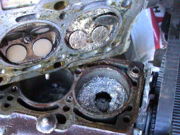Ford 1100 ci Sherman tank engine
Last Updated on July 22, 2024 by Mutiara
| Specs | |
|---|---|
| Bore | 5.4 in / 137.16 mm |
| Stroke | 6 in / 152.4 mm |
| Displacement | 1100 ci / 18.0 l |
| Compression ratio | 7.5 |
| Torque | 1050 ft-lbs at 2200 RPM |
| Horsepower | 500 at 2600 rpm |
Ford’s first overhead cam, 4 valve, aluminum engine was designed for Sherman tanks in WW2. The 1100 ci engine is an all aluminum 60 degree V-8 with dual overhead cams, 4 valves per cylinder, dual carbs, dual magnetos, and hemispherical combustion chambers.
During World War II, Ford developed an aircraft engine similar to that of the Rolls Royce/Merlin and Allison engines of that era. It was a 60 degree V-12, all aluminum (block & heads), dual over cam, 4 valve engine. This engine was built to typical aircraft standards: Light as possible with total reliability and performance in mind. Everything is safety wired or staked with incredible attention to detail on every part. However, this engine never went into production as an aircraft engine.
The Army needed an engine for their new Sherman Tank, however the requirement was that it had to be reduced down to a v8. So Ford lopped off 4 cylinders and it went into production as a v8. This was not a problem, as Henry Ford pioneered the V-8 anyways. The engine was standard in about 13,000 of the 49,000 Sherman Tanks.
This engine is equipped with dual Stromberg 2 bbl carbs, dual magnetos (one for each cylinder bank), exhaust manifolds, water pump, fuel pump, carb linkage, etc. It also equipped with a large aluminum bellhousing, heavy flywheel and super duty dual disc tank clutch. The camshafts are gear driven, but not like that of a Ford 427 SOHC. Rather, they have shafts (1 for each bank) that has another gear on the other end driving both cams simultaneously. Ford actually produced 3 versions of this engine, the GAA, GAF & GAN but the differences were very minor, consisting primarily of different carb types and different governors.
The starter is 24 volt. This engine also has 2 small external drive flanges on the side of the timing chain cover that were used to drive the radiator cooling fans. While it is quite a large engine, it is rather compact due to the 60 degree v8 design rather than the typical 90 degree. Gas mileage was about 0.8 miles per gallon for the 30 ton Sherman Tank.
Present usage
The engine is being used in a 1970 Mustang project, mated to a heavily modified Powerglide trans with a custom adapter and flexplate.









